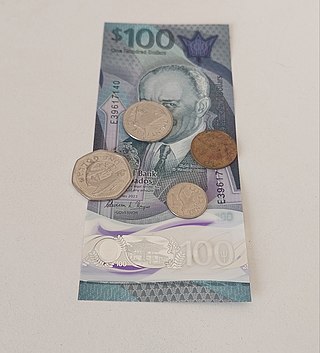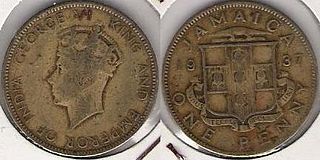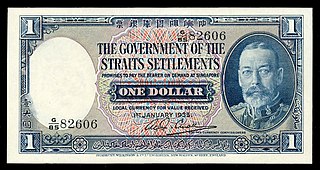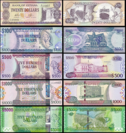Guyanese dollar
Last updated
| |||||
| ISO 4217 | |||||
|---|---|---|---|---|---|
| Code | GYD (numeric:328) | ||||
| Subunit | 0.01 | ||||
| Unit | |||||
| Symbol | $, G$, GY$ [1] | ||||
| Denominations | |||||
| Subunit | |||||
| 1⁄100 | cent | ||||
| Banknotes | $20, $50, $100, $500, $1000, $2000, $5000 | ||||
| Coins | $1, $5, $10 | ||||
| Demographics | |||||
| User(s) | |||||
| Issuance | |||||
| Central bank | Bank of Guyana | ||||
| Website | www | ||||
| Valuation | |||||
| Inflation | 5.8% | ||||
| Source | , 2022 | ||||
The Guyanese dollar (currency sign: $, G$ and GY$; ISO: GYD) has been the unit of account in Guyana (formerly British Guiana) since 29 January 1839. Originally it was intended as a transitional unit to facilitate the changeover from the Dutch guilder system of currency to the British pound sterling system. The Spanish dollar was already prevalent throughout the West Indies in general, and from 1839, the Spanish dollar unit operated in British Guiana in conjunction with British sterling coins at a standard conversion rate of one dollar for every four shillings and twopence. In 1951 the British sterling coinage was replaced with a new decimal coinage which was simultaneously introduced through all the British territories in the Eastern Caribbean. When sterling began to depreciate in the early 1970s, a switch to a US dollar peg became increasingly attractive as an anti-inflationary measure and the Eastern Caribbean Currency Authority (of which Guyana was a member) made the switch in October 1975. The Guyanese dollar is normally abbreviated with the dollar sign $, or alternatively G$ (Guyanese Dollar) to distinguish it from other dollar-dominated currencies.
Contents
History
The history of the Guyanese dollar should not be considered in isolation of the wider picture surrounding the history of currency in the British West Indies as a whole. ( See Currencies of the British West Indies ). The aspects of that history that are peculiar to British Guiana are the continued use of the four pence groat coin when all other territories had abandoned it, and also the use of dollar accounts in both the public and private sectors since 1839. In the other Eastern Caribbean territories, there was a mixture of dollar and sterling accounts until the year 1951.
The Dutch territories of Essequibo, Demerara, and Berbice on the north coast of South America, created in early 17th century, came under the control of the British during the Napoleonic wars. These territories were formally ceded to the United Kingdom in 1815 and united to become the colony of British Guiana in 1831. At first, the British introduced a British variety of the Dutch guilder currency into this territory. Then in 1839, the Spanish dollar as a unit of account was introduced in order to facilitate the introduction of British sterling silver coinage. The rationale behind this lies in the fact that Spanish silver dollars, alternatively known as pieces of eight, were already circulating alongside the Dutch coinage, and also widely throughout the Eastern Caribbean. The dollar unit of account therefore acted as a convenient intermediary conversion unit between sterling and the outgoing guilder unit. The dollar unit was equivalent to 4 shillings 2 pence sterling and replaced the guilder unit at a rate of 1 dollar = 3+1⁄8 guilders, i.e. £1 = $4.80 = 15 guilders.

A particular feature of the circulation of British silver coins in British Guiana was the popularity of the 4d (four pence) coin, known as the groat. This was a direct consequence of its equivalence to the very popular outgoing 'bit' coin which was equal to one quarter of a guilder. When the groat coin ceased to circulate in the United Kingdom in the latter half of the nineteenth century, a special request was made in 1888 for groats to be struck for use in the British West Indies and British Guiana. These were first struck in 1891. From 1917 they were struck exclusively for use in British Guiana.
Spanish, Mexican, and Colombian silver dollars continued to circulate alongside the British sterling coinage until 1876 when these dollar coins were demonetised.
The Spanish dollar unit should not be confused with the American dollar unit. The American dollar unit was first introduced in the US in the year 1792, based on the average weight of a selection of worn Spanish dollars. As such, the American dollar was marginally less valuable than the Spanish dollar.
Coins
After the introduction of the dollar, regular British coins circulated, together with 2 and 4 pence coins also issued elsewhere in the British West Indies. The 2 pence coins issued in 1838, 1843 and 1848 were of the standard Maundy money type, whilst the 4 pence coins bore an image of Britannia. Between 1891 and 1916, 4 pence coins were issued specifically for "British Guiana and West Indies" and between 1917 and 1945 for "British Guiana". 1916 also saw the first issue of paper money by the Government of British Guiana, in denominations of 1, 2, 5, 20 and 100 dollars.
In 1967, coins were introduced in denominations of 1, 5, 10, 25 and 50 cents. The 1 and 5 cents were struck in Nickel-brass, with the other denominations struck in cupro-nickel. In 1996, high inflation caused the introduction of 1, 5 and 10 dollars coins. The 1 and 5 dollars are struck in copper-plated steel, whilst the 10 dollars is struck in nickel-plated steel and has an equilateral-curved heptagonal shape.
In August, 2020, the $100 coin was launched. The coin is the first coloured coin issued by the Bank of Guyana.
Banknotes
Private banknotes were introduced in the late 19th century by the British Guiana Bank and the Colonial Bank. Both issued 5, 20 and 100 dollars. The British Guiana Bank issued notes until 1907, with the Colonial Bank issuing notes until 1917. The Colonial Bank was taken over by Barclays Bank, which issued notes in denominates of 5, 10, 20 and 100 dollars between 1926 and 1941.
In 1909, the Royal Bank of Canada introduced 100 dollars notes, followed in 1913 by 5 and 20 dollars notes. From 1920, the notes also bore the denomination in sterling. 100 dollars were issued until 1920, with the 5 and 20 dollars issued until 1938.
Paper money production specifically for British Guiana ceased in 1942 and local notes were replaced by BWI$ notes in 1951. In 1955, the BWI$ was decimalized and coinage was issued in the name of the "British Caribbean Territories, Eastern Group". In 1965, the East Caribbean dollar (EC$) replaced the BWI$ and circulated in British Guiana for a year until, following independence in 1966, the Guyanese dollar was introduced, replacing the East Caribbean dollar at par.
Banknotes were introduced on 15 November 1965 in denominations of 1, 5, 10, and 20 dollars. [2] A second series issued between 1988 and 1992 consisted of 20, 100, and 500 dollar denominations. The 1996–1999 series included 20, 100, 500, and 1000 dollars. The 2000–2002 series included 500 and 1000 dollar notes. New banknotes of 100 and 1000 dollars were issued on 29 March 2006. The 100-dollar note is similar to the preceding issue of the same denomination, except the design has been slightly modified with larger numerals for the denomination in the upper left front corner, a different screen trap background pattern, and shortened printer imprint. Both notes now have designs that extend to the borders and watermarks that include an electrotype map of Guyana. The 2011 issue included 500 and 1000 dollars with brand new security features, the most notable is the holographic stripe with a colorful macaw replacing the OVD patch used on the previous issues. [3] On November 15, 2013, the Bank of Guyana unveiled the 5,000-dollar note which was issued on December 9. [4] [5] However, there have not been any plans for a circulating non-commemorative 10,000-dollar note for Guyana as of yet. In February 2022, the Bank of Guyana unveiled the 2,000 dollar note.
Commemorative banknotes
- N.D. (2016) 50 Dollars - 50 Years of Independence.
- N.D. (2021) 2,000 Dollars - 55 Years of Independence - being released in late February 2022. [6] This will be the first polymer banknote for Guyana.
| Current GYD exchange rates | |
|---|---|
| From Google Finance: | AUD CAD CHF CNY EUR GBP HKD JPY USD JPY USD |
| From Yahoo! Finance: | AUD CAD CHF CNY EUR GBP HKD JPY USD JPY USD |
| From XE.com: | AUD CAD CHF CNY EUR GBP HKD JPY USD JPY USD |
| From OANDA: | AUD CAD CHF CNY EUR GBP HKD JPY USD JPY USD |
See also
Related Research Articles
The Eastern Caribbean dollar is the currency of all seven full members and one associate member of the Organisation of Eastern Caribbean States (OECS). The successor to the British West Indies dollar, it has existed since 1965, and it is normally abbreviated with the dollar sign $ or, alternatively, EC$ to distinguish it from other dollar-denominated currencies. The EC$ is subdivided into 100 cents. It has been pegged to the United States dollar since 7 July 1976, at the exchange rate of US$1 = EC$2.70.

The Belize dollar is the official currency in Belize. It is normally abbreviated with the dollar sign $, or alternatively BZ$ to distinguish it from other dollar-denominated currencies.
The British West Indies dollar (BWI$) was the currency of British Guiana and the Eastern Caribbean territories of the British West Indies from 1949 to 1965, when it was largely replaced by the East Caribbean dollar, and was one of the currencies used in Jamaica from 1954 to 1964. The monetary policy of the currency was overseen by the British Caribbean Currency Board (BCCB). It was the official currency used by the West Indies Federation The British West Indies dollar was never used in British Honduras, the Cayman Islands, the Turks and Caicos Islands, the Bahamas, or Bermuda.

The Jamaican dollar has been the currency of Jamaica since 1969. It is often abbreviated to J$, the J serving to distinguish it from other dollar-denominated currencies. It is divided into 100 cents, although cent denominations are no longer in use as of 2018. Goods and services may still be priced in cents, but cash transactions are now rounded to the nearest dollar.

The Trinidad and Tobago dollar is the currency of Trinidad and Tobago. It is normally abbreviated with the dollar sign $, or alternatively TT$ to distinguish it from other dollar-denominated currencies. It is subdivided into 100 cents. Cents are abbreviated with the cent sign ¢, or TT¢ to distinguish from other currencies that use cents. Its predecessor currencies are the Trinidadian dollar and the Tobagonian dollar.

The dollar has been the currency of Barbados since 1935. Globally its currency has the ISO 4217 code BBD, however, unofficially in Barbados the International vehicle registration code BDS is also commonly used, a currency code that is otherwise reserved for Bangladesh outside Barbados. As such the present dollar has the ISO 4217 code BBD. The Barbadian dollar is divided into 100 cents.
The Saint Helenapound is the currency of the Atlantic islands of Saint Helena and Ascension, which are constituent parts of the British Overseas Territory of Saint Helena, Ascension and Tristan da Cunha. It is fixed at parity with sterling, and so both currencies are commonly accepted and circulated within Saint Helena. It is subdivided into 100 pence.
The guilder or florin was the currency of the Netherlands from the 15th century until 2002, when it was replaced by the euro.

The Netherlands Antillean guilder is the currency of Curaçao and Sint Maarten, which until 2010 formed the Netherlands Antilles along with Bonaire, Saba, and Sint Eustatius. It is subdivided into 100 cents. On 1 January 2011, in the islands of Bonaire, Saba and Sint Eustatius, the guilder was replaced by the United States dollar. In Curaçao and Sint Maarten, the Netherlands Antillean guilder was proposed to be replaced by a new currency, the Caribbean guilder, but this was stalled indefinitely by negotiations over the establishment of a separate central bank for Curaçao. In November 2020, the Central Bank announced the introduction of the replacement guilder, which was planned to be implemented in the first half of 2021; however, implementation was delayed several times.

The pound was the official currency of Jamaica between 1840 and 1969. It circulated as a mixture of sterling coinage and locally issued coins and banknotes and was always equal to the pound sterling. The Jamaican pound was also used in the Cayman and Turks and Caicos Islands.
The pound was the currency of the Bahamas until 1966. It was equivalent to the pound sterling and was divided into 20 shillings, each of 12 pence. Standard sterling coinage circulated. Apart from a Bahamas penny coin struck in 1806, there were no special coin issues such as were found in Jamaica.
The guilder was the currency of British Guiana between 1796 and 1839.

The Straits dollar was the currency of the Straits Settlements from 1898 until 1939. At the same time, it was also used in the Federated Malay States, the Unfederated Malay States, Kingdom of Sarawak, Brunei, and British North Borneo.

The dollar was the currency of the colony of Newfoundland and, later, the Dominion of Newfoundland, from 1865 until 1949, when Newfoundland became a province of Canada. It was subdivided into 100 cents.
The history of currency in the British colony of Dominica closely follows that of the British Eastern Caribbean territories in general. Even though Queen Anne's proclamation of 1704 brought the gold standard to the West Indies, silver pieces of eight continued to form a major portion of the circulating currency right into the latter half of the nineteenth century.
The history of currency in the British colony of Grenada closely follows that of the British Eastern Caribbean territories in general. Even though Queen Anne's proclamation of 1704 brought the gold standard to the West Indies, silver pieces of eight continued to form a major portion of the circulating currency right into the latter half of the nineteenth century.
The history of currency in the British colony of St. Kitts closely follows that of the British Eastern Caribbean territories in general. Even though Queen Anne's proclamation of 1704 brought the gold standard to the West Indies, silver pieces of eight continued to form a major portion of the circulating currency right into the latter half of the nineteenth century.
The history of currency in the British colony of Saint Vincent closely follows that of the British Eastern Caribbean territories in general. As such, it should not be considered in isolation. In order to get a broad overview of currency in the region, see the article British West Indies dollar.
The history of currency in the British colony of Saint Lucia closely follows that of the British Eastern Caribbean territories in general. Even though Queen Anne's proclamation of 1704 brought the gold standard to the West Indies, silver pieces of eight continued to form a major portion of the circulating currency right into the latter half of the nineteenth century.
The region known as the British West Indies included British Guiana on the South American mainland, British Honduras in Central America, Bermuda, The Bahamas, and Jamaica, along with its former dependencies of the Cayman Islands and the Turks and Caicos Islands. It also included the Eastern Caribbean territories of Trinidad and Tobago, Barbados, the Windward Islands and the Leeward Islands.
References
- ↑ Bank of Guyana. Accessed 2011-02-25.
- ↑ Linzmayer, Owen (2012). "Guyana". The Banknote Book. San Francisco, CA: www.BanknoteNews.com.
- ↑ Guyana new 500- and 1,000-dollar notes confirmed BanknoteNews.com. Retrieved 2011-01-04.
- ↑ Guyana new 5,000-dollar note confirmed BanknoteNews.com. November 16, 2013. Retrieved on 2013-11-21.
- ↑ The Security Features of the Bank of Guyana's 5,000 dollar note
- ↑ Efron, Arnoldo (2022-01-29). "Guyana - New polymer commemorative banknote". MRI Guide. Retrieved 2022-12-18.
- Krause, Chester L.; Clifford Mishler (1991). Standard Catalog of World Coins: 1801–1991 (18th ed.). Krause Publications. ISBN 0873411501.
- Pick, Albert (1990). Standard Catalog of World Paper Money: Specialized Issues. Colin R. Bruce II and Neil Shafer (editors) (6th ed.). Krause Publications. ISBN 0-87341-149-8.
External links
- 20 Guyanese Dollars banknote
- Coins of Guyana Archived 2015-02-11 at the Wayback Machine
Text is available under the CC BY-SA 4.0 license; additional terms may apply.
Images, videos and audio are available under their respective licenses.

